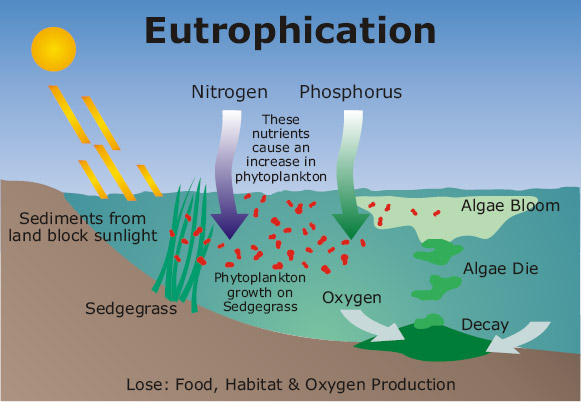In order to mass produce chickens and eggs for consumption, industries prescribe an enormous amount of antibiotics to the chickens. Due to close living spaces and harsh conditions, chickens are more likely to die due to disease. To counteract premature death antibiotics are implemented, resulting in antibiotic-resistant bacteria. According to the FDA, 18 out of the 30 antibiotic feed additives that are being prescribed were classified as a high risk to humans. If such practices continue, a time may come where modern medicine is rendered useless against such bacteria (PETA NA).
Raising billions of chickens a year results in large quantities of feces, 750,000 tons of it to be exact. Such waste contains enough antibiotics and other nutrients to impact surrounding environments. Chicken feces penetrates the soil and is ultimately carried away by bodies of water. As a result, plants are destroyed and water systems are polluted. The waste is said to contain more nitrogen and phosphorus than cow or pig feces. Due to the nutrient-rich feces, rivers, and lakes give rise to excess algae, creating dead zones and destroying aquatic ecosystems (Davis 2016).

According to William and Mary Cunningham, 600 million metric tons or one-third of the world’s grain production is given to livestock as feed. Interestingly, two kilograms of grain is needed to produce one kilogram of chicken meat. Essentially, twice the population could be fed if the grains were consumed directly. Chickens and hens require a lot of water to survive also. According to Moncrief, “Raising animals for food requires up to ten times more water than growing crops.”(Moncrief 2013) To give a better idea, 4000 liters of water is needed to produce a kilogram of chicken meat. In comparison, around 1500 liters of water is used to produce a kilogram of wheat (Cunningham 2017, 160, 256). Keep in mind that wheat is one of the many additives found in chicken feed.
The commodity consumes 25.37 gigajoules of energy per 1000 kilograms and contributes to global warming both directly and indirectly (Leinonen 2012). Although the industry has a far better carbon footprint than beef, it’s certainly not as sustainable as a plant-based diet. According to an article from Greeneatz, chicken and eggs have a CO2 kilo equivalent rating that is 2 to 4 times higher than plant-based foods (Greeneatz NA). Earth doesn’t have an infinite supply of natural resources, yet everyone apparently thinks otherwise as we consume more and more.
References:
Cunningham, William, Mary Ann Cunningham. 2017. Principles of Environmental Science Inquiry and Application. New York: McGraw-Hill Education.
Davis, Karen. 2016. Which Is Worse For The Environment- Poultry Or Beef?. United Poultry Concerns.http://www.upc-online.org/environment/160503_which_is_worse-poultry_or_beef.html
Greeneatz. NA. Food’s Carbon Footprint. http://www.greeneatz.com/foods-carbon-footprint.html
Leionen, A. G. Williams, J. Wiseman, J. Guy, I. Kyriazakis. 2012. “Predicting the environmental impacts of chicken systems in the United Kingdom through a life cycle assessment: Broiler production systems”. Poultry Science 91 (2): 8-25. doi.org/10.3382/ps.2011-01634
Moncrief, Dawn. 2013. 10 Reasons To Say NO To Animal Gifting Hunger Relief Organizations.
Free from Harm. https://freefromharm.org/agriculture-environment/10-reasons-to-say-no-to-animal-gifting-hunger-orgs/
People for The Ethical Treatment Of Animals (PETA). NA. Top 10 Reasons Not to Eat Chicken. https://www.peta.org/living/other/top-10-reasons-eat-chickens/

Leave a comment